12-03-06
I was invited by an associate to come see and hear his audio system. I knew that he has some serious tube equipment (including one of my early P-P amps) but I had never seen it.
Jose’s Sound Room
I took my Lexan Tubelab SE, a (still unfinished) Tubelab SSE, and a box full of tubes, and headed North. When I arrived, I grabbed an amp in each hand, and went inside. As I carried my equipment up the stairs, I could hear someone playing the sax in the room. No, this sound was coming from speakers. The music was playing from a SACD player through a 27 based line stage into a Korneff 45 amplifier.
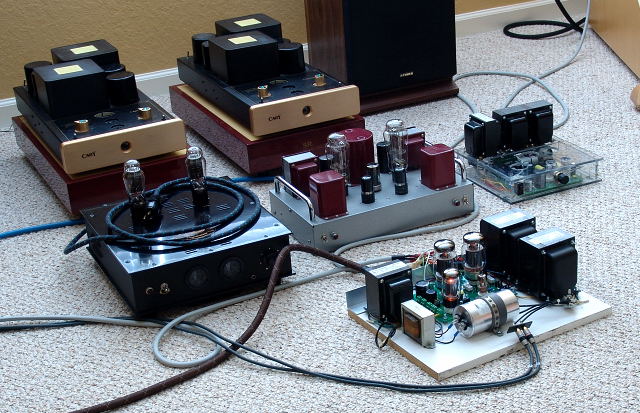
There were several tube amplifiers in the room. All of them were SE amps. The previously mentioned Korneff (center - grey) and a Moth 2A3 (left - black) would be listened to today. Jose, told me that he did not need any more than 1 or 2 watts. His speakers were 106 db efficient. I understand the math (2 watts through 106db speakers sounds like 20 watts through 96db speakers, and 200 watts through 86 db speakers), but It is hard for me to realize how anyone could be happy with 1 watt. Nevertheless, I brought my Tubelab SE with the NX-483 tubes. It makes about 1.5 to 2 watts (right - clear). I also brought a Tubelab SSE (front - powered up) with a wide selection of tubes. There are a pair of Cary 805's in the rear, but they are currently tubeless. They could be deadly through these speakers.
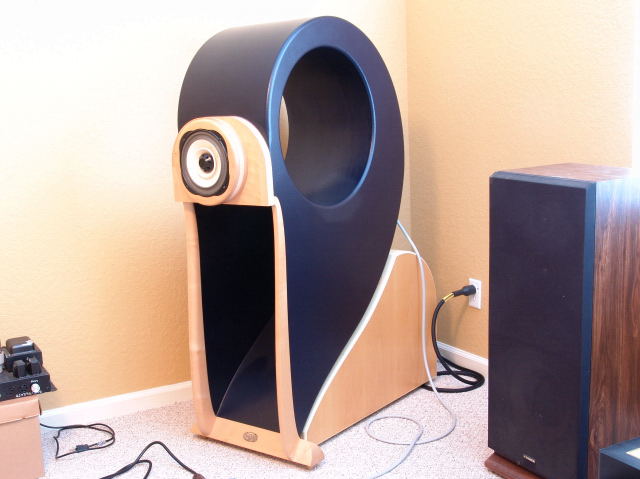
I can not now remember the brand name on the speakers but they were giant horns with Lowther drivers and powered subwoofers.
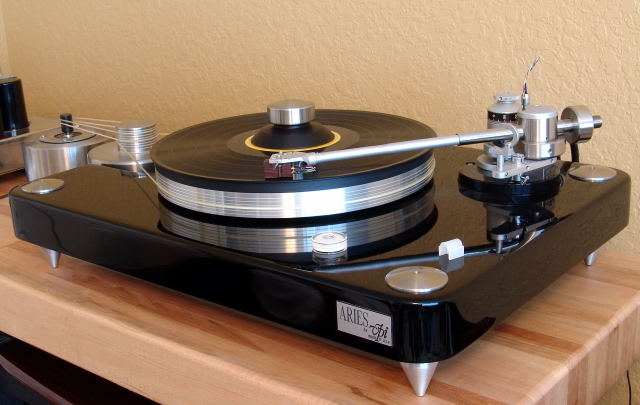
Vinyl? Of course. I thought I was set with my 30 year old Technics direct drive turntable. It was cool with my Pioneer receiver in the 1970's and it sounded awesome with my Phase Linear / Carver setup in the 90's. I never even knew that turntable setups like this existed.
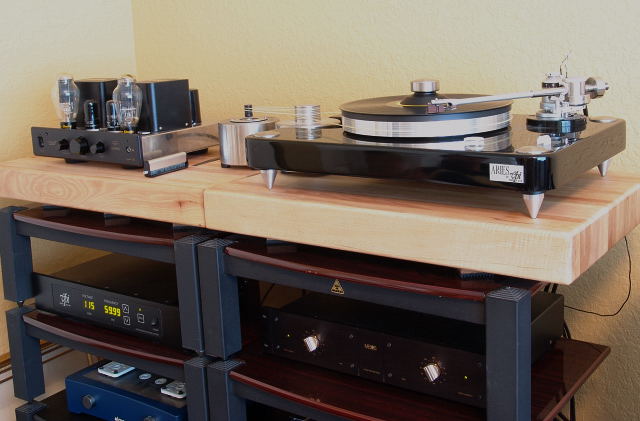
The box on the lower left is the controller. It provides 115 volts AC to the motor. The frequency is adjustable, to control the motor speed. The box on the right is the Melos phono stage. The records were very quiet. No hiss, snap crackle pop stuff. Just clear music. Upper left is "just another 300B amp". Note the yellow printing on the bases of the tubes. A few other amps were laying around the room.
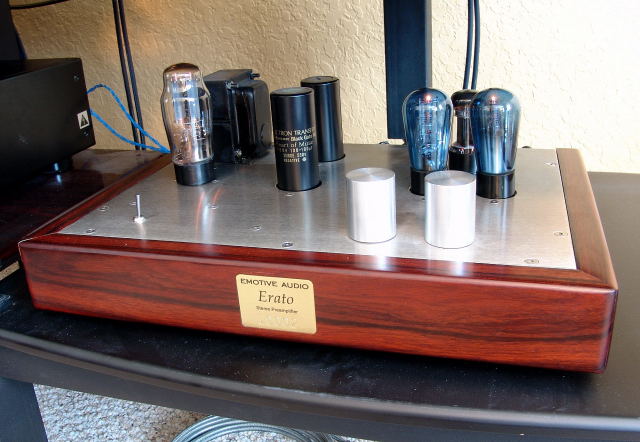
The phono stage or the CD player fed this 27 based line stage. It drove long cables to the amplifier.
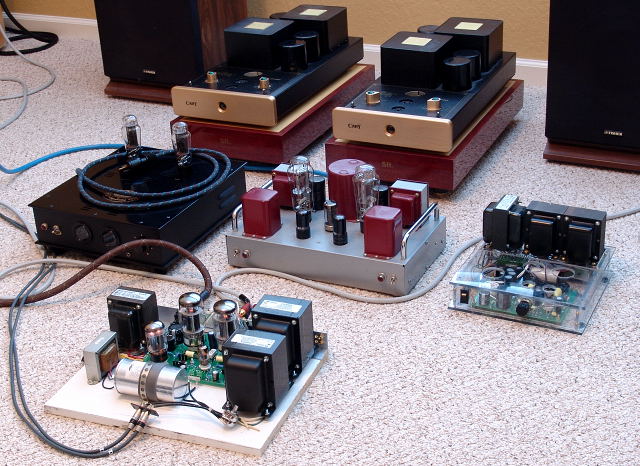 Another picture of the amps.
Another picture of the amps.
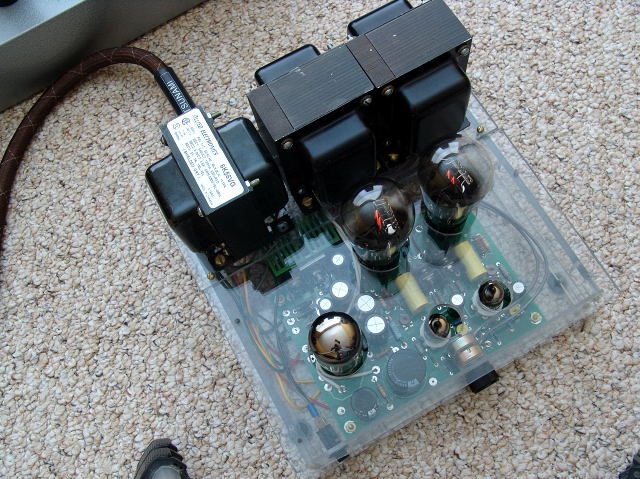
The Tubelab SE with NX-483 tubes. Compare this picture with the one on my home page. The power transformer has been rotated 90 degrees to reduce hum. Not visible is the choke that I added, it is under the right hand OPT. The twisted pair of white wires running across the top of the PC board go to the choke. I have been recommending the choke to customers with efficient speakers, now I finally added it to my amp. I also added a surplus 20uF 400V polyprop cap under the left OPT. Another recommended addition.
The Listening Session
When I was invited to bring a couple of amps to Jose's house, I got my Tubelab SE out of the closet where it has been hiding. I remembered its last visit to some high efficiency speakers, where it went HUMMMMMMM. I had fixed this by rotating the power transformer 90 degrees, but these were 106db speakers. I decided that my CRC power supply was going to become a CLC power supply. I found a power choke of unknown specifications, but 150 ohm DCR, so I wired it in place of the 150 ohm resistor in the power supply. I tested the amp, removed the tubes for transport, and put the amp in the trunk of my car. I also unhooked my SSE, gathered up about 15 pairs of tubes, and headed out.
After listening to a few selections through the Korneff 45, with some monster "45" tubes (300B sized), and Electra Print transformers with shiny Nickel cores, I was beginning to think that my amps could never sound this good. We connected the Tubelab SE with the 76 year old NX-483 tubes (a 5 volt 45), powered it up, and there was NO hum audible with my ear to the speaker. We played some of the same musical selections as before, and we agreed that the two amps sounded very similar. The Tubelab SE may have been slightly "brighter". The differences were subtle.
Next, we connected up the Tubelab SSE, as it was configured in my lab, with the very used "Coke Bottle" 6L6's. The amp was wired for UL mode with cathode feedback, since I run it that way. I need about 10 watts to wake up my 86db Yamaha speakers. On his 106db speakers this was not pretty. As soon as it came up, I could hear that something was not right. The combination that worked best on my 86db speakers, didn't work here. The "bass was not right" and the mids sounded harsh. Switching to triode mode, and turning off the cathode feedback solved the harshness. Jose suggested that I try a different pair of tubes, so I plugged it a pair of Electro Harmonix KT88's since these are quickly becoming my favorites. No adjustments were needed, and the amp came to life. It sounded very good and wasn't intimidated by its surroundings. We listened to it for the rest of the afternoon, and never got around to trying any of the other tubes that I brought.
Jose's super critical listening still heard something that was not right in the bass frequencies. Neither I or the other listener, Ashley, noticed this. We surmised that the Hammond 1628SEA's were somehow causing it. We agreed that there would be more of these sessions, and I will have more amps next time. I could even bring the test amp and a few hundred pounds of transformers. None of the Hammond 1628SEA treble roll - off was noticed. We listened to CD's SACD's and vinyl and all of it was good.
As I was packing up to leave, Jose connected up the Moth 2A3 amp. It had a clearly different sound, but in a good way. It would have been interesting to try 2A3's in the Tubelab SE to see if the tubes were responsible for the difference.
Conclusions
The Tubelab SE could hold its own against the other 2 amps and sounded very similar to the Korneff 45 amp. The Tubelab SSE with no feedback, KT88's in triode mode sounded almost as good. I would have liked to hear some of the other tubes and a few different transformers. That will happen another day.
It was noticed by Jose, that the "bass didn't sound quite right" through his speakers. Neither of the other listeners noticed it. It did not stop us from listening to it for most of the afternoon. We believe that this may be due to the massive size of the OPT's and the fact that they (due to their size) have the most loss of all the transformers that I bench tested a while back. The iron losses tend to be nonlinear due to magnetic hysteresis and other factors. Some of the hysteresis related factors tend to be constant. My normal listening levels are in the 5 to 10 watt range (86db speakers) where the constant effects would be a small percentage of the sound power. The average listening level at Jose's house was probably far less than 1 watt.
How to we test our theory? We repeat the testing using the same amp and a box full of different OPT's. We will get to this, I just don't know when. I never had an opportunity to hear his system before and when we got a combination that sounded good (very good, I might add) we just listened to it!